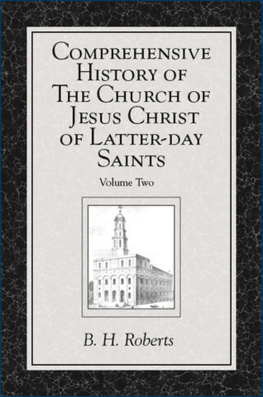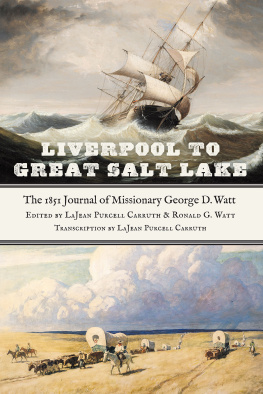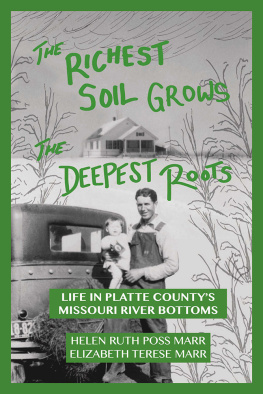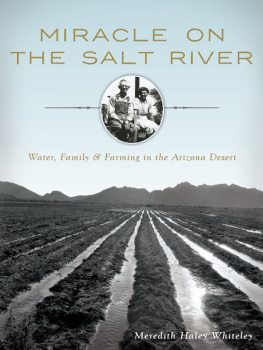The Work and the Glory, Volume 9
All Is Well
Gerald Lund
1998 Gerald N Lund and Kenneth Ingalls Moe.
All rights reserved. No part of this book may be reproduced in any form or by any means without permission in writing from the publisher, Deseret Book Company (permissions@deseretbook.com), P.O. Box 30178, Salt Lake City Utah 84130. This work is not an official publication of The Church of Jesus Christ of Latter-day Saints. The views expressed herein are the responsibility of the author and do not necessarily represent the position of the Church or of Deseret Book. Deseret Book is a registered trademark of Deseret Book Company.
All characters in this book are fictitious, and any resemblance to actual persons, living or dead, is purely coincidental.

Text illustrations by Robert T. Barrett
1998 Gerald N. Lund and Kenneth Ingalls Moe
All rights reserved. No part of this book may bereproduced in any form or by any means without permission in writing from thepublisher, Deseret Book Company, P. O. Box 30178, Salt Lake City, Utah 84130. This work is not an officialpublication of The Church of Jesus Christ of Latter-day Saints. The viewsexpressed herein are the responsibility of the author and do not necessarilyrepresent the position of the Church or of Deseret Book Company.
Bookcraft is a registered trademark of DeseretBook Company.
First printing in hardbound 1998First printing in paperbound 2001First printing in trade paperbound 2006
Visit us at DeseretBook.com
Libraryof Congress Catalog Card Number: 98-74085
ISBN-10 1-57008-563-3 (hardbound)ISBN-13 978-1-57008-563-5(hardbound)ISBN-10 1-57345-878-3 (paperbound)ISBN-10 1-5903-727-9 (tradepaperbound)ISBN-13 978-159038-727-6 (tradepaperbound)
Printed in the United States of America
Publishers Printing, Salt Lake City,UT
10 9 8 7 6 5 4 3 2 1
Forbehold, this is my work and my gloryto bring to pass the immortality andeternal life of man.
Moses 1:39
Tomy mother
EvelynMortensen Lund
whosegentle spirit and manner
haveinfluenced me more deeply
thaneven I fully recognize
Preface
Thestory told by The Work and the Glory series began in the spring of 1827 in Palmyra Township inwestern New York. There we were introduced to the family of Benjamin and MaryAnn Steed. In looking for help to clear his newly acquired farmland, BenjaminSteed hired two brothers, Hyrum and Joseph Smith, who lived on a farm a shortdistance south of the city of Palmyra. Thus did the lives of the Steeds come tobe intertwined with Joseph Smith, the work of the Restoration, and theunfolding destiny of The Church of Jesus Christ of Latter-day Saints.
Wemoved with the Steeds to Kirtland, Ohio, and Jackson County, Missouri; to FarWest and Adam-ondi-Ahman and Hauns Mill. We went with them as they were drivenfrom Missouri to Commerce, Illinois, and watched them help transform a swampinto Nauvoo, the City Beautiful. Then, when once again their enemies threatenedto exterminate them, we saw them abandon that beloved city in the spring of 1846and start across the muddy vastness of Iowa Territory.
Throughthe eyes of the Steeds we have watched as the Book of Mormon came forth, as theChurch was organized, as persecution and ridicule against Joseph Smith swelledin a bitter crescendo. We marched with them on Zions Camp, took hammer and sawand trowel in hand with them as they built first the Kirtland Temple and thenthe magnificent edifice called the Nauvoo Temple. Through their eyes we came toknow the Prophet Joseph Smith and saw his quick humor, his deep love of people,his great vision, and his tragic end in a jail in Carthage, Illinois. Weaccompanied the Steeds on missions, trekked with them as they were driven bytheir enemies, laughed with them in their times of joy, and wept with them intheir times of sorrow.
InSo Great a Cause,volume 8 of the series, we left the Steeds on the banks of the Missouri Riverat Council Bluffs, Iowa. They had no permanent homes. Thousands upon thousandsof Saints were leaving Nauvoo and its surrounding communities and heading westto join Brigham Young and the Twelve. They started out from Nauvoo thinkingthey would go all the way to the Rocky Mountains that year. They soon learnedthat there was no choice but to change their minds. The three hundred twenty-sevenmiles across Iowa in the spring rains took them one hundred and nine days! Theyaveraged only three miles per day. If they had continued at that rate it wouldhave taken them almost another full year to cover the remaining one thousandsixty-seven miles to the Salt Lake Valley.
Throughoutthe series, the events of the Restoration led the Steed family down numerousroads. Often these roads separated and went in different directions. Then, atNauvoo, the paths began to converge again, and for a wonderful time of peaceand happiness the family was together. But it was not to last. The golden yearsin the City Beautiful were quickly coming to an end in sharp, hostile, violentjerks. Once again fate began to have its way with the family, and once againthe Steeds began to be pulled in different directions. Peter and KathrynIngalls decided to find another way west so that they would not be a burden tothe family. They hired on with the family of James Reed and started west withthe Donner Party, a name that would forever be linked with tragedy. Will andAlice were asked by Brigham Young to go to New York and join the group led by Samuel Brannan. Their road would be across the sea, a ten-thousand-milejourney around the southern tip of South America.
InAll is Well,volume 9, we quickly see that the forces of divergence have not yet run theircourse in the family. Within a few days of their arrival at Council Bluffs,Iowa, Captain James Allen rides in and asks Brigham Young for five hundred oftheir best men to march to California. Can the Steed men ignore such a call?When the time finally comes for the move west in the spring of 1847, Brighamdecides that a Pioneer Company must lead the way for the thousands who willfollow. Other companies will come later that same season. The majority willwait until 1848, 1849, even as late as 1852. What does all of this mean for theSteeds? Nor does the fact that the Saints are in exile set aside the duty toproclaim the gospel to the world. Even as they struggle for survival, someLatter-day Saints are called to the eastern states, the southern states,England, the Sandwich Islands. The Steeds have been separated by the call toserve before. Will it once again set some on roads that lead far away from thefamily?
Inmany ways, volume 9 will be significantly different from previous volumes. Forone thing, most of this volume covers a people on the move. Any sense ofpermanence is gone. Even when they stop to build cabins and houses, there is nopurpose but to make shelter until it is time to move again. Canvas and open skybecome the norm now. The days are counted in miles and landmarks. The nightsare spent preparing for the next days march.
Insome waysparticularly from the perspective of a novelistthe storyof Brigham Youngs Pioneer Company of 1847 is anticlimactic. After Iowa, it isalmost deadly dull. There are no deaths. No battles. No tragedies. They movedforward with endless monotony across a thousand miles of plains and deserts andmountains, with nothing more exciting happening than having to ferry across theriver or lock the wagon wheels when they went down a particularly sharpdecline. But this is exactly what Brigham hoped for. This was the result of hismonths of careful planning and preparation. In the novel, whole blocks of daysare completely skipped because there is not much to say except that they keptmoving on. So complete and thorough were President Youngs preparations thatnot until 1856, when the Willie and Martin Handcart Companies left very late inthe season, would any real tragedy strike the Mormon pioneer trains, eventhough thousands upon thousands would follow across the trail blazed by thePioneer Company.





















